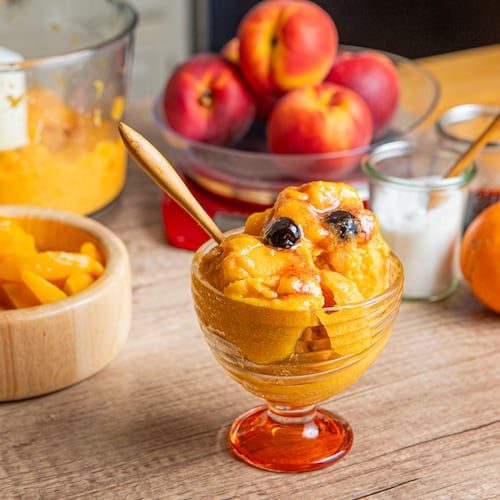Brothers Don and John McLemore fondly recall Thanksgiving 1982 as the time they tried out one of their first and best inventions.
“I called my mom and said, ‘Momma, don’t cook a turkey,’ ” John remembered. “I told her Don and I were going to cook the turkey for the whole family. She kind of got a kick out of that.”
“But I think she was pretty worried about leaving Thanksgiving dinner to a couple of teenage boys,” Don said.
As the favorite family tale goes, Don and John hatched a plot to show up at 4:30 for a 6 o’clock dinner, armed with a raw turkey and their secret weapon, a new turkey fryer they’d fashioned out of a fish cooker.
“To everyone’s amazement, by 6 we had crispy, golden-brown turkey on the table that was succulent on the inside,” John said. “Much to our surprise, we found out the ladies had roasted a backup turkey. But nobody ate it. Everybody liked ours better.”
“It was our first taste test and our first turkey fryer experience,” Don said. “Since then, we’ve never had Thanksgiving without a fried turkey.”
Don and John are partners in Masterbuilt, the Columbus-based company their father, Dawson McLemore, founded in the family’s backyard in 1973. Over the years, the business has grown from making welded steel plant stands to manufacturing a full line of fish cookers, turkey fryers, grills and smokers.
Recently, Don and John were in Atlanta to shoot a how-to video for one of their latest creations, the Masterbuilt Butterball brand indoor electric turkey fryer. John also was busy promoting his new cookbook, “Dadgum That’s Good: Kickbutt Recipes for Smoking, Grilling, Frying, Boiling and Steaming” (Concept Inc., $24.95).
Naturally, the book is aimed at owners of the McLemores' Masterbuilt cooking equipment. But the homey, Southern-flavored recipes easily adapt to other brands and cooking methods.
For the video, John demonstrated one of his signature recipes, a Cajun-style deep-fried turkey that he injects with a buttery marinade and sprinkles with a spicy seasoning mix.
Using the indoor electric fryer with 2 gallons of peanut oil, a 12-pound bird took about an hour to prepare. Everyone present agreed the results were impressive -- a delicious, well-seasoned turkey with crispy brown skin and rich, moist meat. We tested the recipe at home with the same results.
The McLemore brothers said they decided to develop an indoor electric fryer because they’d encountered so many people who wanted to fry a turkey for the holidays but were worried about the safety of outdoor propane gas fryers.
“What we did with the indoor electric turkey fryer was take the fear and guesswork away,” John said. “Someone who has never fried a turkey can follow the step-by-step instructions, dial in the temperature, set the timer and have it come out perfect every time.”
As to the safety claims for the Masterbuilt Butterball indoor electric turkey fryer, the November issue of Consumer Reports declared it “the safest way to fry a turkey,” and the only drawback testers noted was its relatively small maximum 14-pound turkey size.
The McLemore brothers stress safety, no matter if you’re using gas or electric power to deep-fry a turkey. Oil and water don’t mix, they said. Start with a turkey that’s completely thawed and dry. And never leave a fryer unattended.
“Frying a turkey in hot oil calls for a cool head and a bit of caution,” John said. “But it’s worth it. We rarely have any leftovers from our deep-fried turkey.”
Recipes
These recipes adapted from “Dadgum That’s Good” by John McLemore include his signature Cajun deep-fried turkey, a deep-fried turkey breast with a honey and pecan glaze, and a smoked turkey breast that McLemore uses to make turkey salad. The brine, marinades, sauces and seasonings in the recipes can be used with other cooking methods, including grilling and roasting.
Cajun Deep-Fried Turkey With Buffalo Sauce
Serves 6 to 12
Hands on time: 20 minutes
Total time: 2 hours, including soaking, frying and resting
You’ll need an injector syringe, marinade, and Cajun seasoning (available in kits where barbecue grills and equipment are sold) to create the rich, buttery texture and spicy flavor of this deep-fried turkey delight.
For the turkey:
10- to 14-pound fresh or frozen turkey
2 gallons cooking oil, preferably peanut oil
1 (16-ounce) bottle Butterball Buttery Creole turkey marinade
1 (3.7-ounce) jar Butterball Cajun turkey seasoning
For the sauce:
1 (10-12 ounce) bottle of your favorite hot sauce
1/4 cup butter
1/4 teaspoon garlic powder
1 1/2 teaspoons freshly squeezed lime juice
Thaw turkey, if frozen. To properly thaw a frozen turkey in the refrigerator, allow approximately 24 hours for every 4 pounds.
Fill indoor electric turkey fryer with oil to the MAX line and heat to 375 degrees; this may take up to 30 minutes.
Remove giblets and neck from turkey. If present, remove and discard plastic leg holder and pop-up timer. Rinse turkey thoroughly with warm water or completely cover with warm water and soak for no more than 30 minutes to ensure cavities are free of ice. Pat turkey completely dry on outside and inside of cavity with paper towels.
Using an injector syringe, inject 4 ounces turkey marinade into each breast. Inject 2 ounces turkey marinade into each leg and thigh. Sprinkle turkey generously with Cajun turkey seasoning, completely coating the outside of the turkey and inside of the cavity.
Place turkey breast side up in fryer basket. Slowly lower the basket into hot oil, being cautious of splattering. Fry turkey for 3 1/2 to 4 minutes per pound. Lift the basket from the hot oil slowly, hooking the basket’s drain clip into drain clip mounting hole to stabilize as you check doneness.
Insert a meat thermometer in the meaty part of the breast; turkey is done when it reads 165 degrees. If the turkey is not done, lower it carefully back into the oil for an additional 5 minutes. Once the turkey reaches the desired temperature (minimum 165 degrees), turn the turkey fryer to MIN and unplug it from the outlet.
Allow the turkey to rest and drain in the fryer basket for 10 minutes before removing for carving. The turkey can remain in the basket to cool until ready to carve and serve.
To make the sauce: In a medium saucepan over low heat, combine hot sauce, butter, garlic powder and lime juice, and heat through. Use as a dipping sauce or pour over turkey slices.
Per serving, based on 6: 850 calories (percent of calories from fat, 61), 57 grams protein, 26 grams carbohydrates, 2 grams fiber, 59 grams fat (14 grams saturated), 185 milligrams cholesterol, 1,412 milligrams sodium.
Adapted from “Dadgum That’s Good” by John McLemore (Concept Inc., $24.95)
Honey-Glazed Roasted Pecan Deep-Fried Turkey Breast
Serves 6 to 8
Hands on time: 20 minutes
Total time: 2 hours, including soaking, frying, resting and glazing
Savory, sweet and nutty, this deep-fried turkey breast is injected with chicken broth and glazed with honey and pecans.
For the turkey:
2 gallons cooking oil, preferably peanut oil
1 (5- to 7-pound) fresh or frozen turkey breast, bone-in
1 cup chicken broth
For the glaze:
1 cup pecans, halved
1 cup honey
3/4 cup butter
Thaw turkey, if frozen. To properly thaw a frozen turkey breast in the refrigerator, allow approximately 24 hours for every 4 pounds.
Fill indoor electric turkey fryer with oil to the MAX line. Heat to 375 degrees; this may take up to 30 minutes.
For the pecan glaze: Preheat oven to 375 degrees. Spread pecans in a single layer on a baking sheet. Bake 8 minutes, or until lightly browned. Remove from oven, let cool, and chop coarsely, leaving a few whole. In a small saucepan over medium-high heat, combine honey and butter. Stir in chopped pecans and cook for 8 minutes to infuse the flavors. Remove from heat and keep warm.
If present, remove and discard pop-up timer from turkey. Rinse turkey breast thoroughly with warm water, or cover with warm water and soak for no more than 30 minutes to ensure cavities are free of ice. Pat turkey breast completely dry with paper towels, inside and out.
Using an injector syringe, inject 4 ounces of chicken broth into each side of breast.
Place turkey in fryer basket and slowly lower basket into hot oil, being cautious of splattering. Cover and reduce heat to 325 degrees. Fry turkey breast for 7 minutes per pound. After calculated cooking time is complete, lift the basket from the hot oil slowly, hooking the drain clip of the basket into the drain clip mounting hole.
To check doneness, insert a meat thermometer into the meaty part of the breast; it is done when it reads 165 degrees. If turkey breast is not done, lower it back into the oil for an additional 5 minutes.
Repeat basket procedure to check temperature again.
Once turkey breast reaches a minimum temperature of 165 degrees, turn the turkey fryer to MIN and unplug it from the outlet. Allow the turkey breast to rest and drain in the fryer basket for 5 minutes before removing and applying glaze.
Place rested turkey breast onto a platter and pour glaze over top. Carve and serve.
Per serving, based on 6: 975 calories (percent of calories from fat, 68), 31 grams protein, 50 grams carbohydrates, 1 gram fiber, 76 grams fat (23 grams saturated), 114 milligrams cholesterol, 739 milligrams sodium.
Adapted from “Dadgum That’s Good” by John McLemore (Concept Inc., $24.95)
Smoked Turkey Breast
Serves 6 to 12
Hands on time: 15 minutes
Total time: 2-3 hours, plus up to 24 hours for brining
This tender, smoky brined turkey breast recipe is perfect for electric smokers, but easily adapts to gas or charcoal grills.
1 cup kosher salt
1 cup brown sugar
1/2 cup maple syrup
2 quarts apple juice
2 quarts water
3- to 6-pound turkey breast
1 small handful pecan or apple wood chips
To brine the turkey breast
In a large food-safe container, combine the salt, brown sugar, maple syrup, apple juice and water and mix well. Place turkey breast in brine and refrigerate for 12 to 24 hours.
To smoke the turkey breast
Load smoker wood tray with one small handful of wood chips and preheat smoker to 250 degrees.
Remove the turkey breast from brine and pat dry with paper towels.
Reduce smoker temperature to 225 degrees. Place the turkey breast in the smoker and cook for 25 to 30 minutes per pound, or until inside meat temperature reaches 165 degrees. Remove turkey breast from smoker and let rest for 15 minutes before carving.
Per serving, based on 6: 358 calories (percent of calories from fat, 17), 42 grams protein, 31 grams carbohydrates, trace fiber, 7 grams fat (2 grams saturated), 78 milligrams cholesterol, 1,871 milligrams sodium.
Adapted from “Dadgum That’s Good” by John McLemore (Concept Inc., $24.95)
Turkey Salad
Makes 6 salad servings or 36 appetizer servings
Hands on time: 15 minutes
Total time: 15 minutes
Smoked turkey breast adds another level of flavor to this easy turkey salad, but it’s great for any type of turkey leftovers.
2 cups diced turkey
3/4 cup green onions, chopped
3/4 cup celery, chopped
1/3 cup mayonnaise
2 tablespoons fresh thyme, chopped
2 tablespoons lemon juice
1/2 cup toasted hazelnuts or pecans, coarsely chopped
In a large bowl, combine diced turkey, green onions, celery, mayonnaise, thyme and lemon juice. Top with toasted nuts and serve over mixed greens for salads or spread on crackers for canapes.
Per serving, based on 6: 243 calories (percent of calories from fat, 74), 13 grams protein, 4 grams carbohydrates, 1 gram fiber, 21 grams fat (3 grams saturated), 34 milligrams cholesterol, 295 milligrams sodium.
Adapted from “Dadgum That’s Good” by John McLemore (Concept Inc., $24.95)
About the Author
The Latest
Featured

